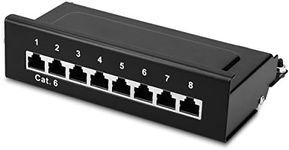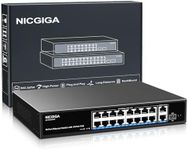Best Poe Switches
From leading brands and best sellers available on the web.
TP-Link
TP-Link TL-SG2428P | Jetstream 24 Port Gigabit Smart Managed PoE Switch | 24 PoE+ Ports @250W, 4 SFP Slots | Omada SDN Integrated | PoE Recovery | IPv6 | Static Routing

TP-Link
37%OFF
TP-Link 48 Port Gigabit Ethernet Switch | Plug and Play | Sturdy Metal w/ Shielded Ports | Rackmount | Fanless | Traffic Optimization | Unmanaged (TL-SG1048) , Black

YuanLey
24 Port Gigabit Ethernet PoE Switch with 2 Uplink Gigabit Port & 2 SFP Port, YuanLey Unmanaged 24 Port PoE+ Network Switch, Rackmout, Build in 400W Power, Support 802.3af/at, Plug and Play

TP-Link
TP-Link TL-SG105PP-M2 | 5 Port 2.5 Gigabit Switch | Multi-Gigabit | 4 PoE++ Ports @123W | Fanless Metal Design | Plug & Play | PoE Auto Recovery | QoS & IGMP

TP-Link
TP-Link TL-SG116P | 16 Port Gigabit PoE Switch | 16 PoE+ Ports @120W | Plug & Play | Extend, Priority & Isolation Mode | PoE Auto Recovery | Fanless | QoS & IGMP Snooping

TP-Link
TP-Link TL-SG1210PP | 8 Port PoE Switch | 6 PoE+ and 2 PoE++ Ports @123W, w/ 2 Uplink Gigabit Ports + 1 Combo SFP Slot | Plug & Play | Priority, Extend & Isolation Mode | QoS, IGMP, PoE Auto Recovery

YuanLey
Yuanley 24 Port PoE Switch with 2 Gigabit Ethernet Uplink Port, Unmanaged 26 Port 802.3af/at 400W Power PoE+ Network Switch, Rackmount Plug and Play

TP-Link
TP-Link TL-SG105MPE | 5 Port Gigabit PoE Switch | Easy Smart Managed | 4 PoE+ Ports @120W, w/ 1 Uplink Gigabit Port | QoS, Vlan, IGMP & LAG | Fanless | PoE Auto Recovery

MokerLink
6%OFF
MokerLink 16 Port PoE Switch with 2 Gigabit Uplink Ethernet Port, 250W High Power, Support IEEE802.3af/at, Rackmount Unmanaged Plug and Play
Our technology thoroughly searches through the online shopping world, reviewing hundreds of sites. We then process and analyze this information, updating in real-time to bring you the latest top-rated products. This way, you always get the best and most current options available.

Most Popular Categories Right Now
 Yehudah Posnick
Yehudah PosnickBuying Guide for the Best Poe Switches
Power over Ethernet (=PoE) is a means of powering a device by means of the Ethernet cable running from the router or modem to the device. Very similar to the way your landline phone gets its power from the phone line, you can operate security cameras or a card reader by providing it power from its Ethernet cable. This way, you don’t have to worry about charging up the device’s batteries, providing it with AC current from a wall outlet, or having to hook up an AC/DC transformer to provide power. It won’t require any complicated electrical work to power up devices--just hook them up with an Ethernet cable, and you’re done!
A Power-over-Ethernet switch (PoE switch) allows you to connect many devices at once. They will be be both connected to the Internet, and get their power from the Ethernet cable. But PoE switches can differ in the amount of power that they can provide, the number of devices that you can connect, data transmission speed, the number uplink ports, and many other details. It’s important to be well-informed, to make a wise decision as to which PoE switch will best suit your needs.
We’ve composed this buyer’s guide to help you make the right decision when selecting a PoE switch. It'll help you:
-
Choose the right type of PoE switch,
-
See useful tips about that type of PoE switch,
-
Read reviews of different PoE switches, and what customers are saying,
-
Select the right brand of a PoE switch, and
-
Compare prices and find the best deals.
Types
-
PoE and PoE+: You’ll see some switches that are “PoE+”. That “+” indicates that it provides more power to each connected device than you would expect in a standard PoE switch. Regular PoE provides 15.4 Watts of power, and PoE+ provides 25.5 Watts sustained power, and 30 Watts maximum peak power. This way, you can connect more devices to a switch, without having to worry that it will exceed the switch’s power supplying limits. (Note: You’ll also see PoE+ being called IEEE protocol 802.3at, the upgrade over regular PoE, which is standard 802.3af.) A PoE+ switch has enough power to run a security camera that not only takes pictures, but can even employ night vision or a motor that moves the camera from side to side. For example, Real HD makes an 8-Port PoE+ switch that has a maximum power output for 120 Watts, so that each camera will receive 15 Watts of power.
-
Unmanaged vs. managed switches: You will see that some PoE switches are “unmanaged”, while others are “managed”:
-
An unmanaged switch is primarily for consumers who don’t need any special Internet security. It will allow Ethernet devices to communicate with each other, such as a PC and network printer or other “plug and play” devices. An example is the Real HD 8-Port PoE+ Switch.
-
Real HD 8-Port PoE+ Switch
-
-
On the other hand, a managed switch will allow for controlling Internet traffic for businesses that operate servers and enterprises, where they can custom-manage ports with different bandwidth speeds, and give greater priority to some ports more than others. NetGear makes “Smart Cloud” managed switches, where you can monitor the switch’s use with a smartphone or tablet. There are also “fully managed” switches, such as the NetGear 12-Port Gigabit Desktop Managed ProSafe PoE Switch. It has special features to prioritize and control network traffic.
-
Netgear 12-Port Gigabit Desktop Managed ProSafe Switch (Model No. GSM5212)
What Reviewers Have to Say
-
Useful for a network of video cameras or IP telephones: If you want to create a network of video cameras, a PoE switch can expand a network created by a router, using the same network as the Network Video Recorder (=NVR). Another common use for a PoE switch is for setting up a network of IP telephones. Since each phone needs a power supply, it’s best to power them by means of its Ethernet cable. That’s a better alternative than relying on them connecting to the Internet wirelessly.
-
Notation when dealing with channels: Maybe you’ll see a switch with a spec like “8 + 1 channels”. This indicates the number of channels supported by the PoE switch. In this case, it means that there are 8 ports for cameras, phones, and other devices, providing them both power and data transmission. The “+1” indicates that there is an additional port to connect the PoE switch to a router--this channel only performs data transmission.
-
Speed: You’ll want to look at the maximum data transfer rate of your switch. Some switches will support both 10 Mbps standard Ethernet, as well as 100 Mbps Fast Ethernet. Some switches will even be capable of 1000 Mbps data transfer.
Important Features
-
How to connect up a PoE switch: A PoE switch will get its power from wall current. They typically will be able to receive either 110 V or 230 V, so one device will be suitable anywhere in the world without the need for a voltage converter. You then hook up the individual devices--IP phones, or IP security cameras, for example--to the individual ports by means of Ethernet cables.
-
The total power output of the switch: The number and types of devices that you can connect at once to your PoE switch will depend on 1) the power output of which the switch is capable, and 2) the power demands of each device attached. For example, the BV-Tech 5 Port Gigabit Poe+ Switch is capable of providing 65 Watts of power to the devices attached. But, those 65 Watts will divide up among the various devices attached. So, even if each port can supply 30 Watts of power, if you hook up 4 devices, each port can only supply 65 Watts/4 = 16.25 Watts. So if you hook up 4 security cameras, each one should require no more than 16 Watts.
-
PD (=Powered Device) Detection: Not all devices can receive their power over an Ethernet cable. What happens if you hook up a device to your switch that isn’t PoE compatible? For that, you want a switch with PD Detection: the switch will determine if the device can be powered over Ethernet or not. If it detects that a device isn’t PoE-compatible, it won’t supply it with any voltage. That’s important--without PD detection, you could risk burning out the device that you attach. Some switches have some PoE ports and some regular ports. But then you have to be careful about plugging non-PoE devices in the correct ports.
-
The number of uplink ports: Let’s say that you want to hook up 5 devices to a PoE switch, but it only has 4 Ethernet ports. You may want to hook up two switches together, to allow for more ports. An uplink port is what allows for connecting two switches together. You can connect the uplink port of one switch to the output of another switch, thereby effectively connecting them. (However, with today’s switches, you may be able to connect any port on one switch to another other port on the switch that you are adding.) The Real HD 16-Port PoE Switch has 16 PoE ports, as well as 2 Gigabit Ethernet uplink ports, and 1 SFP (Small-form Pluggable) port, for optical fiber cable devices.
Real HD 16-Port PoE Switch
-
Data transfer rates: You’ll see switches that say that each port will support both “full-duplex and half-duplex data transfer”. “Duplex” means that information is transferred in both directions. When they say that a port is “full-duplex”, it’s able to transmit and receive information in both directions at the same time. On the other hand, “half-duplex” means that information goes in both directions, but only one direction at a time. Full-duplex saves time over half-duplex, as there are fewer retransmissions of data. But half-duplex is able to conserve bandwidth. So, you’ll see that a switch can transfer data on Ethernet at 10 Mbps when operating at half-duplex, and twice that (20 Mbps) when operating at full-duplex.
Top-Rated Brands
BV Tech makes PoE injectors, repeaters, and switches, security cameras, DVRs and NVRs, security systems, and more. Their switches can support anywhere from 4 devices to massive systems of 26 devices. They are based near Chicago, Illinois.
Real HD manufacture a wide range of IP cameras and PoE switches. Their PoE products designed to be simple to install and use, and are made to protect non-PoE devices from being damaged.
Netgear is a maker of networking products for consumers, businesses, and service providers. They were founded in 1996, and are based in San Jose, California. They make DSL and cable modems, routers, network switches, IP cameras, and much more.
TRENDnet has been making networking products since 1990. They are based in Torrance, California. Their products include wired and wireless routers and adapters, access points, modems, network switches, Power-over-Internet devices, and more.














